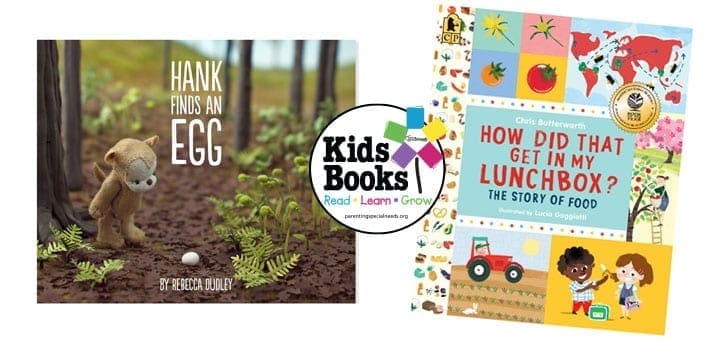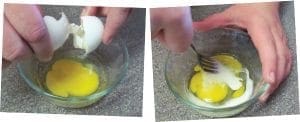Encouraging Speech & Creating Yum! Easy Scrambled Eggs
Teaching our children to cook is a crucial life skill. This recipe comes courtesy of Beverly Worth Paloma from her new cookbook, Special Day Cooking. Beverly has 11 years of experience teaching culinary arts to special-needs students. She found her students were successful using certain teaching strategies. Wanting her students to continue beyond her classroom to cook for themselves every day, she searched for a cookbook that enforced these teaching methods. She found there wasn’t a cookbook on the market that helped strengthen these critical teaching methods. As a result, she decided to fill that void and created Special Day Cooking: A Life Skills Cookbook.
Recipes are in large type and easy-to-follow steps for all skill levels. They are safe — needing only a microwave, toaster or blender, and a plastic knife for cooking…sometimes no equipment is required at all.
Ingredients
Makes 1 Serving
- 1 egg
- 1 tablespoon milk
- Salt and pepper shakers
Gather Equipment
Put a paper towel on your cooking area to catch spills.
- Microwave
- 1 small microwave-safe bowl
- Measuring spoons
- 1 small bowl
Catch spills: measure over a bowl.
- 1 kitchen fork
- 1 kitchen teaspoon
- 2 potholders
- 1 serving plate
Cooking Directions
- Crack egg into small microwave-safe bowl.
- Measure 1 tablespoon of milk. Add to egg.
Catch spills: measure milk over a small bowl then add to egg.
- Add 2 dashes of salt and pepper to egg.
- Mix with kitchen fork.
Cook Egg
- Microwave egg 30 seconds. Remove bowl from microwave with potholders.
- Mix with a kitchen fork.
- Microwave egg again 30 seconds. Remove bowl from microwave with potholders.
- Mix with a kitchen fork.
- Spoon onto a serving plate.
Recipe from Special Day Cooking: A Life Skills Cookbook by Beverly Worth Palomba. Special Day Cooking is available at www.Specialdaycooking.com [4] and on Amazon [5].
Language Tips for Cooking Microwave Scrambled Eggs
An ideal way to focus on language and learning during cooking time, is with a very simple recipe. With this recipe for a scrambled egg, all you need are three ingredients: one egg, milk and some seasoning.
Before beginning the recipe, talk with your child about what you are making and what ingredients you need to make the recipe. Show the ingredients to your child and talk about the egg before cracking it into the bowl. Discuss the color, shape and texture. Begin a conversation with your child about where an egg comes from.
Work on sequencing by reviewing the steps of the recipe.
What do you need to do first? First, you need to crack the egg and put it in the bowl. What happens if you get the egg all over your hands? This can be an ideal opportunity for your child to remember to wash their hands after they handle a raw egg.
Encourage Commenting and Describing
Once you are done cracking the egg, have your child measure out the milk and add it to the recipe. Work on the actions “crack”, “mix”, and “measure”, “pour”. As your child is mixing the egg and milk, encourage commenting and describing. What color is the mixture? What does it look like? For example, you might describe the mixture as “wet” and “gooey”. To work on prediction, ask your child what will happen once you cook the egg. Will it still be gooey or will the texture change?
Ask Questions about the Recipe?
Follow the recipe for cooking the egg, mixing and then finishing the cooking of the egg in the microwave. Before you take the egg out of the microwave, ask your child if they think the egg will be hot or cold. What should we do if the bowl is hot?
Problem Solving and Safety Rules
This is an excellent opportunity for your child to problem solve that he or she needs to handle the bowl with a potholder to avoid burning themselves. Learning to teach a child and a teenager with special needs how to use a microwave is a valuable lesson. The microwave can be a great cooking appliance if used correctly. When cooking this recipe, it might be an ideal opportunity to talk about the safety rules of the microwave. For example, asking your child, “What would happen if we put the fork in the microwave with egg”?
Check out this website for more safety rules in the microwave [6].
Once your egg is cooked to its desired texture, place it on the plate and sit down with a carryover picture book to read with your child as you eat. Use the conversation starters attached to use when eating together.

Recommended Picture Books: Hank Finds an Egg [7], Green Eggs and Ham by Dr. Seuss, Scrambled Eggs Super by Dr. Seuss, How Did That Get In My Lunchbox [8].
*TIP* As you are cooking the recipe together, take pictures of each step so that you can help your child recall the steps to the recipe easier. These photos can serve as a visual aid when remembering information. Print out the pictures, laminate the images and attach some Velcro to the back. Use a felt board and have your child put the pictures in order. If you want to do this on the iPad, use an app such as Making Sequences or Go Plan.
Conversations Starter Ideas
Language Tips by Becca Eisenberg
Becca Eisenberg is a mother of two young children and a speech-language pathologist, author, and instructor. Her website, www.gravitybread.com [10], encourages learning time during mealtime. On her website, she writes children’s book recommendations, app recommendations, as well as child-friendly recipes with language tips for their family.
Helpful Articles
- Cooking with Kids: Hatching “wide-eyed” Chicks (Deviled Eggs) [11]
- Cooking With Kids: Egg-Sicles [12]
Visit us at www.facebook.com [13]
This post originally appeared on our January/February 2015 Magazine [14]




